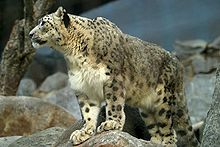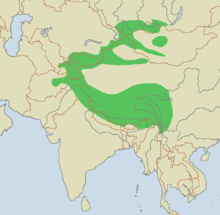Snow Leopard
| Snow leopard | |
|---|---|
 |
|
| Snow leopard in the San Diego Zoo | |
| Scientific classification | |
| Kingdom: | Animalia |
| Phylum: | Chordata |
| Clade: | Synapsida |
| Class: | Mammalia |
| Order: | Carnivora |
| Family: | Felidae |
| Subfamily: | Pantherinae |
| Genus: | Panthera |
| Species: | P. uncia |
| Binomial name | |
|
Panthera uncia (Schreber, 1775) |
|
| Subspecies | |
 |
|
| Range map | |
| Synonyms | |
The snow leopard or ounce (Panthera uncia syn. Uncia uncia) is a large cat native to the mountain ranges of Central and South Asia. It is listed as Endangered on the IUCN Red List of Threatened Species because, as of 2003, the size of the global wild population was estimated at 4,080–6,590 adults. Fewer than 2,500 individuals may be reproducing in the wild. As of 2016, estimates for the size of the global population vary from at least 4,080 to about 8,700 individuals.
Snow leopards inhabit alpine and subalpine zones at elevations from 3,000 to 4,500 m (9,800 to 14,800 ft). In the northern range countries, they also occur at lower elevations.
Taxonomically, the snow leopard has been classified as Uncia uncia since the early 1930s. Based on genotyping studies, the cat has been considered a member of the genus Panthera since 2008. Two subspecies have been attributed, but genetic differences between the two have not been settled.
Both the latinized genus name, Uncia, and the occasional English name ounce are derived from the Old French once, originally used for the European lynx. Once itself is believed to have arisen by back-formation from an earlier variant of lynx, lonce – the "l" of lonce was construed as an abbreviated la ('the'), leaving once to be perceived as the animal's name. This, like the English version ounce, came to be used for other lynx-sized cats, and eventually for the snow leopard.
...
Wikipedia

